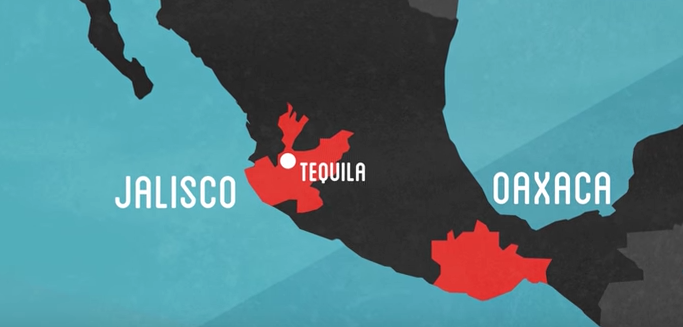Posted: May 03, 2017
 Source: HTME
Source: HTMEDeep in the highlands of Jalisco, the scrubland slopes are filled with smallholdings. Farmers there tend spiky blue agaves, much the same way as they have for generations. They coax them to maturity for several years, a labor-intensive process aimed at producing a hearty core, or piña, that can be roasted in prep for tequila-making. It’s a cottage industry, and one that—at least at first—seems almost determinedly retro.
Then the buzzing starts. It isn’t a bee or a tractor, but rather a drone, swooping through the sky as it photographs and scans every plant. It doesn’t ruffle the farmers, though: The drone is just a sign that the Tequila Regulatory Council is undertaking one of its intermittent inspections, which more resemble a scene from a spy novel than the Farmer’s Almanac.
The Tequila Regulatory Council, or CRT, is tasked with enforcing the strict rules around tequila farming and production. Founded in 1994, the privately run non-profit is the booze world’s version of the FBI; it polices the production of tequila, with a particular focus on protecting the appellation of origin, which outlines various requirements for any producer who wants to claim its tequila is 100 percent blue agave.
Ismael Vicente is its head of agriculture, and was the mastermind behind introducing the drone program. “We’re using technology to map exactly the 125,000 hectares that form the whole region of origin for tequila—that’s 25,000 agave plantations,” he explains, via a translator. “We’re trying to get agricultural precision, a very clear snapshot of where we are in terms of agave supply.”
Vicente has been finessing the monitoring program for twenty years. Today, he’s able to use technology to create a detailed, photographic map of the entire appellation, largely by relying on the Geomatica program that helps process satellite-produced images, as well as GPS data and the farmers’ own registrations. Once the overall map has been updated, Vicente scans for any anomalies or aberrations then sends in the drones—these act like an agricultural SWAT team, with a mission to explore anything Ismael has flagged. “When it looks like you have an issue in an area, you send in a drone to give more precise details,” he continues. “After seeing the images, a group of experts can go to that field and see what the exact situation is.”
It’s easy to understand why the CRT would be so territorial: Tequila forms a crucial cornerstone of the Mexican economy. A recent Technavio report into the global market for tequila predicted it would reach $9.17 billion by 2021, a rise of 16 percent since 2016. Seventy percent of production is earmarked for export, of which almost 80 percent is guzzled stateside.
The sheer scale and size of blue agave’s sanctioned production area is staggering: 340 million plants, scattered through 181 municipalities and five Mexican states according to CRT President Ramon Gonzalez. Given this scope, satellite data and drones are ideal for undertaking initial inspections before humans are sent to investigate any farms that raise flags.
Those satellite and drone maps are also cross referenced whenever an inspector arrives at a particular plantation: Does the number of blue agave plants recorded from space correspond with the number the farmer claims he has supplied to a tequila producer? It’s accurate down to a single bush.
Bertha Gonzalez Nieves is a maestra tequilera and the co-founder of ultra-premium Casa Dragones. She has seen the painstaking, high tech process first hand. “I spent days trying to understand the process. You got with a verifier to a field, and they measure one side to another, then count the lines [of plants], then do a mathematical equation which they use to catalog the number of plants,” she marvels. “It gives you a sense of how well run the appellation of origin is.”
Indeed, the CRT’s program isn’t the only GPS-mapping project—some larger producers run their own, in-house counterparts, including Patrón and Jose Cuervo, though are often tight-lipped as to the exact details.
Of course, though the CRT suggests its satellite monitoring is largely driven by logistics, there are murkier motives, too. One is the looming threat of disease that could wipe out blue agave supplies. It’s a built-in risk given how the plants are now propagated. Modern production methods have produced a dearth of genetic diversity in today’s blue agave, leaving it particularly vulnerable to disease. Quickly identifying and treating blighted agave plants is critical for the industry overall.
Likewise, that master blueprint of all the farms can also be used to police less scrupulous producers who smuggle agave in from outside the appellation of origin area, often from Oaxaca, to bulk out supplies and improve margins; by one insider’s estimates, this happens any time there is a shortage—as there is right now.
“From my perspective, because we’re Mexican, we have a certain reputation, perhaps that people think we can’t be that formal,” says Bertha Gonzalez-Nieves, “It makes sure that when it says the word tequila on the label, it’s in sync with the appellation of origin. This shows how we’re really serious about our spirit.” Pause and consider that the next time you’re sipping a margarita.
By Mark Ellwood
May 01, 2017
Source: Food and Wine
Go-Wine's mission is to organize food and beverage information and make it universally accessible and beneficial. These are the benefits of sharing your article in Go-Wine.com
 Source: HTME
Source: HTME
The Wine Thief Bistro & Specialty Wines is a locally owned small business in downtown Frankfort, IL offering world class wines in a relaxed, casual gathering spot for friends and family. Offering world class virtual tastings and touchless carryout.
https://www.twtwineclub.com/aboutus
Go-Wine 25 Great Wineries in US selection prioritizes quality, value and availability.
www.go-wine.com/great-wineries-in-america
Tasting wine is a nice experience, but visiting the places in which wine is made is a magic moment. Available in New York City for touchless pickup.